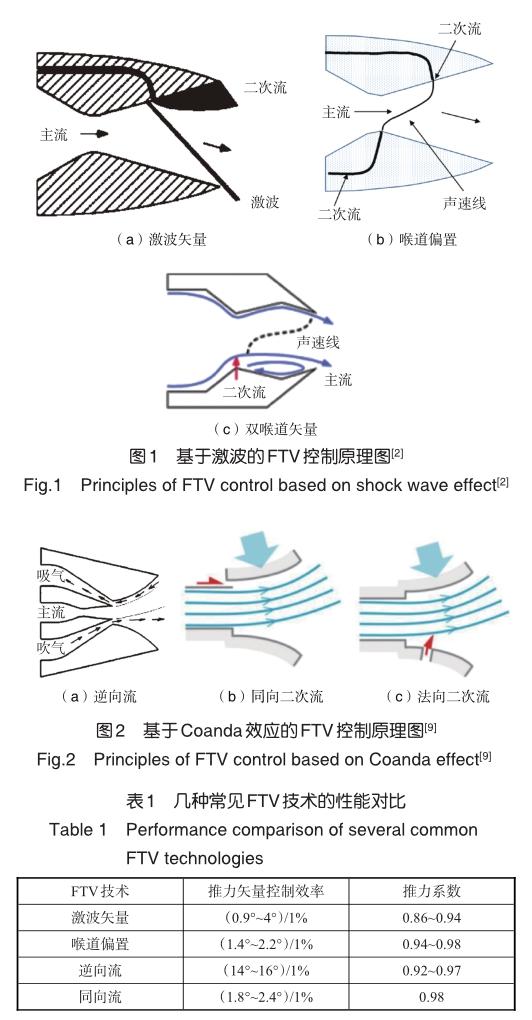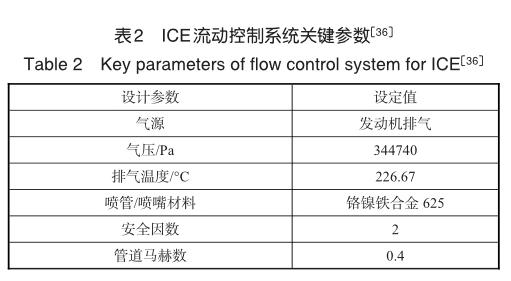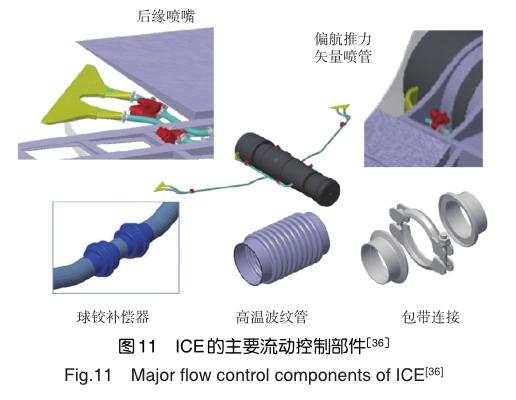流体推力矢量技术的应用验证研究进展
瞿丽霞 李岩 白香君
摘要:流体推力矢量(fluidic thrust vectoring,FTV)技术是利用二次流诱导主流偏转、实现推力转向的新型流动控制技术。概述了FTV技术的空气动力学原理,详细综述了FTV技术的应用验证研究进展,对FTV技术未来发展提出了几点建议:开展FTV喷管几何参数的精细化设计以实现高效可靠的推力矢量控制;通过不同层次的系统集成验证加速推动FTV技术的工程应用;探索环量控制机翼(circulation control wing,CCW)和FTV协同控制完全替代活动舵面的最优方案。
关键词:流动控制;Coanda效应;流体推力矢量;二次流
中图分类号:V211.4文献标识码:ADOI:10.19452/j.issn1007-5453.2020.05.009
推力矢量控制(thrust vectoring control,TVC)技术是指推进系统既能为飞行器提供前飞推力,还能使发动机推力转向,同时或單独产生俯仰、偏航、滚转的控制力及力矩,可以直接对飞行器姿态进行控制或者取代部分舵面的控制功能,实现原有飞行器无法做到的机动或大迎角飞行。TVC通常被分为机械式和流体式两类[1-2]。公开资料显示,已应用机械式推力矢量技术并装备形成战斗力的军机有美国的F-22和俄罗斯的苏-35。但由于结构重量(质量)大、活动部件多、偏转机构复杂、主喷流偏转响应慢、推力损失大等固有缺陷,一定程度上阻碍了机械式推力矢量技术在飞机上的应用[3]。流体推力矢量(FTV)技术属于主动流动控制技术范畴,一般是通过在结构固定的喷管上用射流或引气的方式调控主流流量和方向,从而产生推力矢量[4]。无运动部件的结构特点,使得FTV不但规避了机械式TVC的固有缺陷,同时在隐身、减重、机动等方面比机械式TVC优势显著。理想状况下,FTV可为高机动飞机提供足够的俯仰控制力矩,也可为无尾/飞翼布局飞机提供三轴稳定性控制力矩[2]。
1 FTV技术的空气动力学原理
从空气动力学角度来讲,FTV技术可以分为激波控制和科恩达(Coanda)控制两类。其中,激波控制类包括激波矢量、喉道偏置和双喉道矢量等,控制原理类似,即在喷管不同位置注射二次流产生斜激波来改变主流方向,进而实现推力矢量化,如图1所示。激波控制的矢量控制规律曲线线性度较好,但是由于主喷流需要穿过激波使推力损失大、总矢量偏角小,导致能耗高效率低。Coanda控制包括逆向流、同向流以及无源二次流等,其控制原理均以Coanda壁面为主要构型,借助Coanda效应同时利用二次流与发动机主喷流剪切层的相互作用实现矢量控制,如图2所示。Coanda控制与激波控制相比,能够获得相对较大的矢量角和较高的控制效率[5-8]。表1列出了几种常见的激波控制和Coanda控制的FTV技术性能对比,可以看出,Coanda控制的推力矢量控制效率和推力系数总体上高于激波控制。但是Coanda控制在某些情况下存在推力矢量偏转规律曲线非线性、迟滞和突跳等问题。随着人们对Coanda效应FTV技术的探索,这些问题已有初步解决方案。本文主要讨论基于Coanda效应的FTV技术应用验证研究进展。
2 FTV技术的应用验证
参考文献[1]、参考文献[2]、参考文献[5]~参考文献[8]对FTV技术的工作机理机制、数值模拟方法、试验技术等进行了详细的综述。美国Rohr公司联合美国航空航天局(NASA)兰利研究中心于1993年首次提出基于Coanda壁面的吹气控制方法,这是同向流控制的雏形。随后,国外多位学者[10-20]对同向流FTV技术开展了深入、系统的研究。北约从20世纪70年代开始实施“创新控制效应器”(Innovative Control Effectors)项目,开发主动流动控制(AFC)技术,并于2013年联合多家机构成立了AVT-239任务组(NATO AVT-239),针对流动控制技术应用于未来无人机系统开展5年性能评估[21]。北约、英国BAE系统公司虽已将流体飞行控制技术推进到装机试飞阶段,如2010年9月试飞的DEMON无人机和2019年5月首飞的MAGMA无人机,但实际装备流体矢量喷管进行飞行控制的飞机较少。据猜测,美国的X-36、X-45可能使用了流体矢量喷管控制偏航,以取代垂尾。国内近年来比较有代表性的是南京航空航天大学FTV研究团队[6-8,22,23],针对小雷诺数、小尺寸验证机(如“暗流”“驭风”)开展了较为系统的研究,但在大雷诺数、大尺寸验证机上的适用性有待进一步研究。鉴于上述流动控制技术的前传扰动机理,目前已有的相关应用验证研究均集中在亚声速范围内开展。
2.1基于Coanda效应的同向流FTV技术
DEMON无人机的两次飞行测试展示了FLAVIIR(Flapless Air Vehicle Integrated Industrial Research)项目集成的CC滚转控制、先进飞行控制等诸多技术,尚未对FTV系统进行飞行测试,但该系统已在曼彻斯特大学风洞中成功展示[24]。DEMON的飞行速度范围为38~60m/s。为了在DEMON上实现完全流动控制飞行,牺牲了项目指标中机动性、速度、载重等关键指标,整机重量(质量)也从计划的50kg增加到90kg[24-26]。DEMON的流体飞行控制系统由CCW和FTV喷管两部分组成[27](见图3)。CCW是基于Coanda效应改变空气沿机翼表面的流动方向,从而产生相应的控制力矩来实现滚转控制,通过控制边界层流动,该系统还可以在飞行器起飞和降落阶段提供更大的升力;FTV喷管利用发动机推力矢量化来进行控制,通过二次流引导主流从安装在矩形排气喷嘴中的Coanda表面流出以控制飞行姿态。


3发展建议
经过近年来的持续探索,国内外研究人员在FTV领域已经积累了非常丰富的研究经验,国外科研机构已开展了若干次飞行试验验证,推动了FTV技术成熟度的显著提升。通过上述针对FTV技术进行应用验证研究的技术细节分析,对今后FTV技术研究提出如下的发展建议,为FTV技术如何进入工程化应用提供一定的参考。
(1)FTV的技术难点之一在于,引入的二次流很难对发动机喷流进行精准控制,实施不当有可能使主喷流偏转不够降低控制效率,或者过偏转失控,以及出现双稳态、迟滞、非线性现象。对比BAE系统公司研发的两代验证机DEMON和MAGMA在FTV系统关键结构特征的演变,FTV喷管形状、尺寸等核心几何参数是获得可靠性能的关键。因此未来的重点工作应对喷管结构进行精细化设计,通过精准的几何形状控制来调节二次流以及主流的流动性能,以保证获得高控制效率的同时具有良好的控制响应特性。
(2)FTV技术工程应用需要更多的系统集成性验证,由于涉及各项系统的匹配与衔接问题,在孤立的FTV设备上无法发现的问题,只有在不同层次的系统集成验证中才能发现并解决。例如,通过系统集成进一步研究和掌握FTV技术的时变性能。一方面是发动机对矢量系统瞬态操作的闭环响应,即快速/间歇性需求对发动机性能的影响;二是外部流对由流体推力矢量系统引起的局部变化响应时间,了解控制阀操作与飞机负载之间的关系,以探索飞行器对干扰抑制的响应。利用二次流进行飞行控制,若需要从发动机引气,就会降低发动机性能。需要在概念设计阶段考虑飞发一体化设计,综合评估发动机性能下降和获得控制收益的关系,研究如何利用最少的二次流实现预定的偏转控制。试飞验证方面,有限的试飞中,只是在低速平飞状态下对流体飞行控制系统进行了演示,起降、机动等其他复杂飞行条件尚未有报道,并未验证低速大迎角飞行时的控制特性,高马赫数飞行的试飞验证仍然具有极大的挑战。
(3)能否采用流动控制技术在亚声速范围内替代活动操纵面,以彻底解决活动舵面带来的隐身、维护、重量等问题,是未来飞行器设计的研究热点之一。已有研究表明,FTV技术在进行纵向俯仰控制时效率较高,也可用于无尾布局的航向控制,但是尚不能完全替代全部舵面以实现飞机六自由度操控。目前可行的方案是将CCW与FTV配合使用,CCW主要用于横向操控和提供起降升力,FTV俯仰控制力矩较大,可弥补CCW纵向力矩小的不足。在DEMON和MAGMA两架验证机上均采用了CCW和FTV协同控制,NATO AVT-239任务组对各类流动控制技术进行综合评估时,认为ICE和SACCON的流体飞行控制最优方案是CCW和FTV两项技术的组合使用。未来的研究工作可以延续这个思路,继续探索CCW和FTV的最优协同控制方案。此外,流动控制技术在超声速领域的应用,还需要探索其他其他解决方案。
参考文献
[1]Deere K A. Summary of fluidic thrust vectoring research conducted at NASA langley research center[R]. AIAA-2003-3800,Orlando,Florida:2003.
[2]肖中云,江雄,牟斌,等.流体推力矢量技术研究综述[J].实验流体力学,2017,31(4):8-15. Xiao Zhongyun, Jiang Xiong, Mou Bin, et al. Advances in fluidic thrust vectoring technique research[J]. Journal of Experiments in Fluid Mechanics, 2017,31(4):8-15. (in Chinese)
[3]贾东兵.关于推力矢量控制技术的探讨[J].航空动力,2018(3): 25-27. Jia Dongbing. Discussion on thrust vector control technologies[J]. Aerospace Power, 2018(3):25-27. (in Chinese)
[4]徐悦,杜海,李岩,等.基于射流飞控技术的无操纵面飞行器研究进展[J].航空科学技术,2019,30(4):1-7. Xu Yue, Du hai, Li Yan, et al. Progress research of fluidic flight control technology for flapless aircraft[J]. Aeronautical Science& Technology, 2019,30(4):1-7. (in Chinese)
[5]韩杰星.流体矢量喷管内外流耦合研究[D].南京:南京航空航天大学,2018. Han Jiexing. A study for inner-outer flow coupling of the fluidic thrust vector nozzle[D]. Nanjing: Nanjing University of Aeronautics andAstronautics, 2018. (in Chinese)
[6]溫俊杰.无源受控扰动下Coanda附壁射流离壁过程研究[D].南京:南京航空航天大学,2019. Wen Junjie. Study on the transient separation process of Coanda wall-attached jet under passive controlled excitation[D].Nanjing:NanjingUniversityofAeronauticsand Astronautics, 2019. (in Chinese)
[7]赵雄.基于无源流体推力矢量喷管的飞行器控制技术试验研究[D].南京:南京航空航天大学,2018. Zhao Xiong. Experimental research on vehicle control technology based on passive fluidic thrust vectoring nozzle[D]. Nanjing: Nanjing University of Aeronautics and Astronautics, 2018. (in Chinese)
[8]林泳辰.新型流体矢量喷管的应用研究[D].南京:南京航空航天大学,2019. Lin Yongchen. An application research on the new fluidic thrust vector nozzle[D]. Nanjing: Nanjing University of Aeronautics andAstronautics, 2019. (in Chinese)
[9]Warsop C,Crowther W J. Fluidic flow control effectors for flight control [J].AIAAJournal,2018,56(10):3808-3824.
[10]Warsop C,Forster M,Crowther W J. Supercritical Coanda based circulation control and fluidic thrust vectoring [R]. AIAASciTech Forum. San Diego,CA:2019.
[11]Mason M,Crowther W J. Fluidic thrust vectoring of low observable aircraft [C]// CEAS Aerospace Research Conference,Cambridge,2002.
[12]Pilmoor M. Pitch control of a low observable UAV using fluidic thrust vectoring [D]. Manchester:Manchester University,2009.
[13]Gill K J. The development of coflow fluidic thrust vectoring systems [D]. Manchester:Manchester University,2009.
[14]Lytton A. Large-scale application of fluidic thrust vectoring[D]. Manchester:Manchester University,2005.
[15]Chippindall J. Geometric optimisation of nozzles for supersonic fluidic thrust vectoring [D]. Manchester:Manchester University,2010.
[16]Ashley J. Aft deck supersonic thrust vectoring [D]. Manchester:Manchester University,2011.
[17]Jegede O. Dual-axis fluidic thrust vectoring of high aspectratio supersonic jets [D]. Manchester:Manchester University,2016.
[18]Afilaka O. Normal blowing fluidic thrust vectoring for supercritical aft-deck convergent-divergent nozzles [D]. Manchester:Manchester University,2017.
[19]Song M J,Chang H B,Park S H,et al. Application of backstep coanda flap for the supersonic co-flowing fluidic thrust vector control [R]. San Jose,CA:AIAA-2013,2013.
[20]Clandra S T,Kushari A,Mody B,et al. Fluidic thrust vectoring using transverse jet injection in a converging nozzle with aft-deck[J]. Experimental Thermal and Fluid Science,2017,86:189-203.
[21]蔡琰.國外射流飞行控制技术发展及前景分析[J].航空科学技术,2020,31(1):85-86. Cai Yan. Development and prospect analysis of foreign fluidic flightcontroltechnology[J].AeronauticalScience& Technology, 2020, 31(1): 85-86. (in Chinese)
[22]曹永飞,顾蕴松,韩杰星.流体推力矢量技术验证机研制及飞行试验研究[J].空气动力学学报,2019,37(4):593-599. Cao Yongfei, Gu Yunsong, Han Jiexing. Development and flight testing of a fluidic thrust vectoring demonstrator[J]. Acta Aerodynamics Sinica, 2019,37(4):593-599. (in Chinese)
[23]龔东升,顾蕴松,周宇航,等.基于微型涡喷发动机热喷流的无源流体推力矢量喷管的控制规律研究[EB/OL].航空学报, http://kns.cnki.net/kcms/11.1929.v.20191221.1554.004.html. Gong Dongsheng, Gu Yunsong, Zhou Yuhang, et al. Research on control law of passive fluid thrust vector nozzle based on the thermal jet of micro turbojet engine[EB/OL]. Acta Aeronautica et Astronautica Sinica, http://kns.cnki.net/kcms/11. 1929.v.20191221.1554.004.html. (in Chinese)
[24]Fielding J P,Mills A,Smith H. Design,build and flight of the Demon demonstrator UAV[C]//11th AIAA Aviation Technology,Integration,and Operations(ATIO)Conference,Virginia Beach,VA,2011.
[25]Fielding J P,Lawson C P,Pires R,et al. Development of the Demon Technology Demonstrator UAV [C]//ICAS 2010,27th International Congress of the Aeronautical Sciences. Nice,France,2010.
[26]Savvaris A,Buonanno A,Tsourdos A. Design and development of the DEMON UAV fluidic flight control system [C]// Guidance,Navigation,and Control and Co-located Conferences,Boston,MA,2013.
[27]Crowther W J,Wilde P I A,Gill K,et al. Towards integrated design of fluidic flight controls for a flapless aircraft[J]. Aeronautical Journal,2009,113(1149):699-713.
[28]Wilde P,Buonanno A,Crowther B,et al. Aircraft control using fluidic maneuver effectors [C]// 26th AIAAApplied Aerodynamics Conference,Honolulu,Hawaii,2008.
[29]Sobester A,Keane A. Multi-objective optimal design of a fluidic thrust vectoring nozzle [C]//11th AIAA/ISSMO Multidisciplinary Analysis and Optimisation Conference,Portsmouth,Virginia,USA,2006.
[30]Burley J R. Circular to rectangular transition ducts for high aspect ratio non-axisymmetric nozzles [C]// SAE,ASME & ASEE Joint Propulsion Conference,1985.
[31]Gill K G,Wilde P I A,Crowther W J. Development of an Integrated propulsion and pneumatic power supply system for flapless UAVs [C]// 7th AIAA Aviation Technology,Integration and Operations Conference(ATIO),2007.
[32]Warsop C,Crowther W J,Shearwood T. NATO AVT-239 task group:flight demonstration of fluidic flight controls on the MAGMA subscale demonstrator aircraft [C]// AIAA SciTech Conference,2019.
[33]Hutchin C. NATO AVT-239 task group:control effectiveness and system sizing requirements for integration of fluidic flight controls on the SACCON aircraft configuration[C]//AIAA SciTech Forum,2019.
[34]Miller D N,Williams D,Warsop C,et al. NATO AVT-239 task group:approach to assess prospects of active flow control on a next-gen tailless aircraft [C]// AIAA SciTech Conference,2019.
[35]Niestroy M A,Williams D R,Seidel J. NATO AVT-239 Task group:flow control simulation of the tailless ICE aircraft [C]// AIAASciTech Forum. San Diego,CA,2019.
[36]Maines B H,Miller D N. NATO AVT-239 task group:flow control system integration into the tailless ICE aircraft[C]// AIAASciTech Conference,2019.
[37]Phillips E,Jentzsch M,Menge M,et al. NATO AVT-239 task group:on the use of active flow control to change the spanwise flow on tailless aircraft models,thus affecting their trim and control [C]// AIAA SciTech Forum. San Diego,CA,2019.
[38]Warsop C,Smith D R,Miller D N. NATO AVT-239:innovative control effectors for manoeuvring of air vehicles-conclusions and next steps[C]//AIAASciTech Conference,2019.
[39]Niestroy M A,Dorsett K M,Markstein K. A tailless fighter aircraft model for control-related research and development[C]//AIAASciTech Conference,2017.
[40]Williams D,Osteroos R,McLaughlin T. NATO AVT-239 task group:flight control derivatives using active flow control effectors on the ICE/SACCON UCAS model [C]// AIAA SciTech Conference,2019.
[41]Miller D N,Maines B H,Niestroy M A. NATO AVT-239 task group:results to assess prospects of active flow control on a next-gen tailless aircraft [C]// AIAA SciTech Forum. San Diego,CA,2019.
(責任编辑陈东晓)
作者简介
瞿丽霞(1986-)女,博士,高级工程师。主要研究方向:计算流体力学、空气动力学、航空数值模拟技术。
Tel:010-84933672
E-mail:qulixia2005@163.com
Application Verification Research Progress on Fluid Thrust Vectoring Technology
Qu Lixia*,Li Yan,Bai Xiangjun
Chinese Aeronautical Establishment,Beijing 100012,China
Abstract: Fluid Thrust Vectoring (FTV) technology is a new flow control technology that uses secondary flow to induce mainstream deflection and achieve thrust steering. The aerodynamic principles of FTV technology are summarized. The application verification research progress on FTV technology is reviewed in detail. Some suggestions for the future development of FTV technology are proposed: conduct refined design of FTV nozzle geometric parameters to achieve efficient and reliable thrust vector control; accelerate the engineering application of FTV technology through different levels of system integration verification; explore the optimal solution of circulation control wing (CCW) and FTV collaborative control to completely replace the active rudder surface.
Key Words: flow control; Coanda effect; fluidic thrust vectoring; secondary flow

